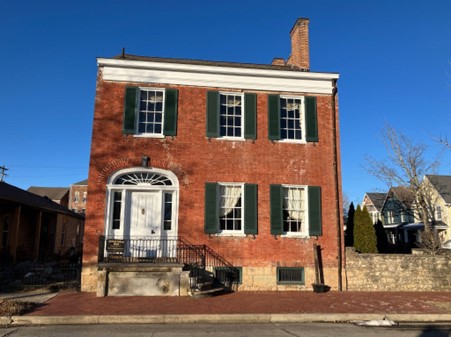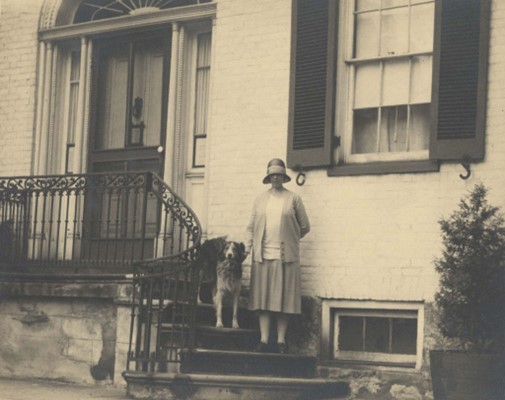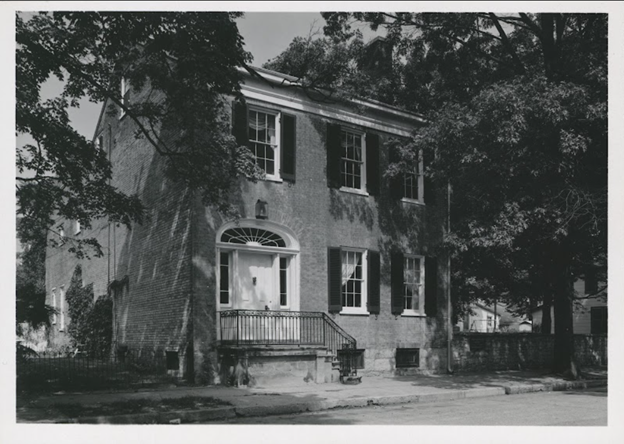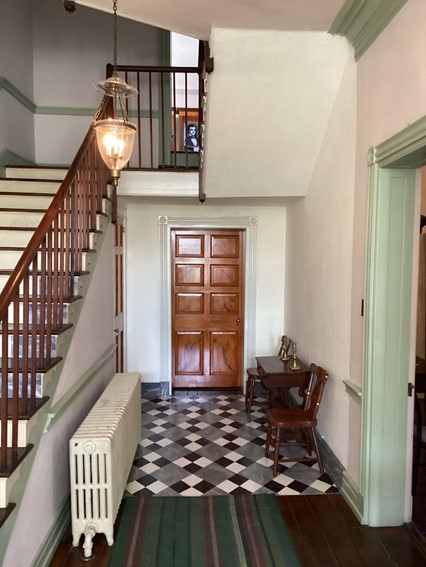This post is contributed by Lexi Traylor and Jessica Spiess from AMM member museum Historic Madison, Inc.
In historic Madison, Indiana, we know the importance of embracing the future while preserving the past. The Sullivan House has witnessed over 200 years of American history in the heart of Madison’s National Historic Landmark District, now serving as a staple of Madison’s historic community. Built about 1820 in a frontier town on the Ohio River, the Sullivan family Federal-style home connects to many historical themes including American architecture, the Civil War, American government and jurisprudence, and the Indiana legal system. Owned and operated by Historic Madison, Inc., a not-for-profit historic preservation organization, its importance transcends these connections to foundational American ideals. The Sullivan House’s sophisticated design, its degree of preservation, and the Sullivan family’s association with the broad currents of local, state, and national history designate it as a paragon of historic preservation, restoration, and development efforts.
The site has undergone many changes and phases since its construction around 1820. An intensive analysis of the site’s physical structure and historical significance in 2023 has revealed secrets about the home’s past. To continue preserving its history, Historic Madison, Inc. is commencing plans for an expansive restoration project that will return the Sullivan House to its Sullivan interior and continue telling the story of the site’s evolution from a family home to a museum.
The story of the Sullivan House preserves the legacies of the family who lived there, shares the stories of the people who restored it over the years and looks towards the future with a new restoration project that aims to maintain the historical integrity of the museum site and its links to American history.
The history of the site begins circa 1820 with Jeremiah Sullivan, who commissioned this federal-style building to be a home for his family. The Sullivan family grew to include Jeremiah and his wife Charlotte Cutler, their eleven children, and his parents. Jeremiah served as an Indiana Supreme Court Justice and a well-respected member of the state legislature. He is also recognized as the man who suggested the name of our state capitol, Indianapolis. Two of his sons also became well-known figures in American history. Algernon Sidney Sullivan was a prominent lawyer during the Civil War and founded Sullivan & Cromwell in New York, which remains one of the largest law firms in the world and is sometimes described as the General Motors of law firms. Jeremiah (Jerry) C. Sullivan was a Brigadier General in the Union Army during the Civil War, serving on General U.S. Grant’s staff.
During the nearly 60 years that the Sullivan Family owned the home, many impressive individuals resided there. Charlotte raised their children, eight of whom lived to adulthood, and managed a home that hosted several family members, guests, and domestic and indentured servants. Conversations around the dinner table would have been filled with topics such as state politics, views on the practice of slavery, and the outcomes of pressing court cases. Local, state, and national history are suffused in the hand-formed brick walls of the Sullivan House. A member of the Sullivan family lived in the home until 1880.
Efforts to preserve the building began in 1927 when the Sullivan House was purchased by Louise Gibb and her husband, William Gibb. They saw the importance of the building and its history, spending 2 years and over $16,000 (more than $280,000 today) to purchase and thoughtfully renovate the home following the Colonial Revival style of the time. Mrs. Gibb’s many renovations included installing hundreds of yards of wallpapers, crown and chair molding, and revamping the electrical, plumbing, and heating systems. She was the last private owner of the home, caring for it until 1960. Mrs. Gibb’s era of ownership paved the way for future preservation efforts.
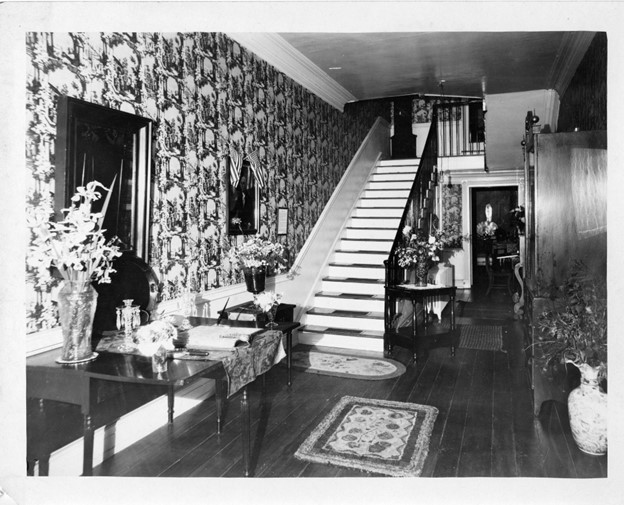
The front hallway of the Sullivan House upon completion of Mrs. Louise Gibb’s restoration circa 1928-1929.
In 1960, Madison’s preservation efforts stepped forward in a big way. Historic Madison, Inc. was founded by John and Ann Windle out of their passion to maintain the rich history of the small river town, starting with the Sullivan House. They created HMI to save the Sullivan House from the possibility of being demolished after Mrs. Gibb’s ownership. With the help of other passionate Madisonians and a gift from Eli Lilly, HMI successfully saved the Sullivan House. The preservation of other historic sites followed.
Although the Sullivan House was saved by HMI in 1960, John Windle did not want to simply conserve the home – he wanted to engage the Madison community and share its history in a meaningful way. With the means and knowledge available at the time, John Windle restored the house to what he believed was the original Sullivan design. This included the removal of 1920s wallpapers, plaster repairs and repainting plaster and woodwork in the entire home, mechanical upgrades and development of exhibit spaces in the basement, and improvements to the grounds. The Sullivan House opened to the public in 1963, showcasing a small but important collection of Sullivan family artifacts and period furnishings. Madisonians and visitors alike experienced the family home and learned about its role in American history. It has been open for tours ever since.
The house has remained nearly the same since 1963, but the time has come for some much-needed maintenance and care which triggered the most recent turning point for the site in 2022-2023 with HMI’s commission of the Sullivan House Historic Structures Report. Thanks to the report’s extensive dive into the physical history of the house and utilization of tools such as paint analysis, HMI gained a clearer understanding of what the home truly looked like during the years it belonged to the Sullivan family. The newfound information from the Historic Structures Report (HSR) is informing current repairs and restoration. The first floor is planned to be restored to the early look the Sullivan family would recognize. The second floor will be rehabilitated for museum exhibits that highlight the Sullivan family and the Gibb era of ownership. Because of the HSR, the construction and restoration plans will be easier to develop and aid the team in crucial decision-making and planning for the future.
In the fall of 2024, HMI created a restoration vignette on-site to provide the community with a sneak peek of what’s to come based on the information provided in the HSR. The Director of Maintenance and Preservation, David Cart, restored a small portion of the hallway to look similar to what it would have looked like when Jeremiah and his family resided in the home. When visitors enter the front hallway, they can see the early 1960s decorative scheme alongside the vignette of the past, creating a dynamic display of the site’s many phases throughout its history. The restored vignette includes a white-wash look on the plaster, faux marbleized baseboards, faux mahogany wood-grained doors, and a period-appropriate replica oilcloth floor covering. These custom alterations accurately reflect the early Sullivan-era decor.
Since its creation, responses have been both positive and exciting. The vignette has been an excellent tool for engagement with the community. It will remain a feature of tours as the project develops. It demonstrates that our view of the past can be informed by careful research and scientific testing of materials, proving that preserving the past also means looking toward the future.
The Sullivan House restoration project also represents the diverse ways we can conduct historical preservation efforts. This isn’t the first HMI site to be thoroughly restored. The last project, the Shrewsbury-Windle House, was completed in 2018 at the cost of more than $2 million and nearly 5 years of work. The Shrewsbury-Windle House project was completed in tandem with a general contractor and a team of specialists to serve as an event space and historic site. Conversely, the Sullivan House project will be completed in-house with HMI staff serving as the general contractor and with the sole intent of operating as a museum space. While both the Shrewsbury-Windle House and Sullivan House sites are historic spaces for the community to enjoy, their approach to engagement, preservation, and enrichment differs.
You can keep up with the Sullivan House restorations by following us on social media or visiting us in person to take a tour of our six publicly available sites. You can learn more on our website at www.historicmadisoninc.com. We are committed to valuing the past to enrich the future, and the Sullivan House encapsulates that mission.
The story of the Sullivan House in Madison, Indiana will continue to be an influential representation of historic preservation’s importance in our world. It began with the Sullivan family and the early history of our nation (c.1820-1880); it transformed with Mrs. Gibb and the first efforts of historic preservation (1927-1960); it was saved by the creation of HMI (1960); and today, it is being restored and revived to its historic glory. The Sullivan House evolves with the times but always remembers the past and the people who helped to preserve it.

